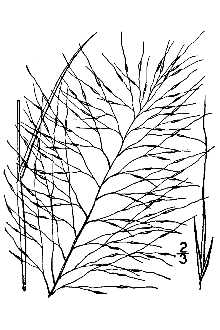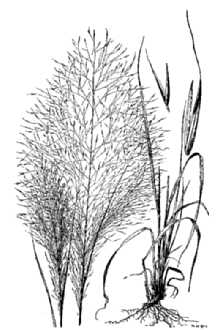Hairawn Muhly
Scientific Name: Muhlenbergia capillaris (Lam.) Trin.

| General Information | |
|---|---|
| Usda Symbol | MUCA2 |
| Group | Monocot |
| Life Cycle | Perennial |
| Growth Habits | Graminoid |
| Native Locations | MUCA2 |
Plant Guide
Use soil moisture sensors to measure the soil moisture of Hairawn Muhly.
Fact Sheet
Alternate Names
Purple muhly grass Pink muhly Hair grass Gulf muhly Long-awn hairgrass Muhly grass Hairy-awn muhly
Uses
Conservation: Hairawn muhly is a hardy and drought-tolerant native ornamental grass that can be used for land reclamation. It is also useful as a fine fuel for understory burn management programs. Landscaping and wildlife: Hairawn muhly produces striking pink and purple blooms in the fall. It requires little maintenance and is excellent for meadow gardens and as a general garden plant. Hairawn muhly is known to attract beneficial insects such as ladybug beetles (Coccinella spp.). The clumping habit of hairawn muhly makes it excellent for use as wildlife cover.
Status
Hairawn muhly is listed as an endangered species in Connecticut, Indiana, Maryland, and New Jersey; as extirpated in Pennsylvania; and as presumed extirpated in Ohio. Please consult the PLANTS Web site and your State Department of Natural Resources for this plant’s current status (e.g., threatened or endangered species, state noxious status, and wetland indicator values).
Description and Adaptation
Adaptation
Adaptation
Hairawn muhly is a native, perennial, warm-season grass that grows from 1–3 feet tall with a 2–3 foot spread. The stems are un-branched and have an upright habit. The wiry, thin leaves are 18–36 inches long, simple (not made up of multiple leaflets), and alternate (progressing singly up the stem). The leaves are green throughout the summer and turn copper in the fall. The purplish-red or pink flowers are grouped together in a long, diffuse, airy, grouping of flowers which mature from the bottom up. The cluster of flowers is arranged on a stem that is about 18 inches long and 10 inches wide and rises above the leaves. The seed stalks are 2–5 feet tall. Flowers give way to oblong tan or brown seed less than half an inch long. Hairawn muhly clumps but does not spread through above or underground stems (stolons or rhizomes). Hairawn Muhly distribution from USDA, NRCS PLANTS database For updated distribution, please consult the Plant Profile page for this species on the PLANTS Web site.
Establishment
Seeds should be collected from plants in late fall and air-dried for five to ten days, Collect seeds during the warmest and driest time of day using a comb to avoid disturbing the appearance of the plant, For greenhouse propagation, plant seeds in the winter in order to have full plants which are ready for spring planting, Use soil moisture sensors to measure the soil moisture of Hairawn Muhly., Seeds do not need a cold treatment for germination, If direct-seeded outdoors, plant seeds one-eighth of an inch deep in rows spaced 24–48 inches apart, Keep soil moist at all times during establishment, Fertilization is not recommended for stands that have been sown directly, Propagate by dividing existing clumps in early spring and summer, Do not divide clumps during the flowering stage,
Management
Burn or mow hairawn muhly stands in late winter to remove old residue. Hairawn muhly prefers neutral to slightly acidic soils but can tolerate many soil types. It has a low tolerance for high pH soils and a high tolerance for salinity. Hand-weed established stands and fertilize according to soil test recommendations.
Pests and Potential Problems
Aphids are known to infest hairawn muhly blooms during the early stages of seed development. Increasing the numbers of beneficial insects such as ladybug beetles may be a natural means of biological control.
Environmental Concerns
No concerns at this time. Cultivars, Improved, and Selected Materials (and area of origin) There are no recommended cultivars or selected materials at this time. Hairawn muhly is available from commercial nurseries specializing in native plants. Prepared By: Samantha Kirk and Shawn Belt, NRCS, Norman A. Berg National Plant Materials Center, Beltsville, MD
Plant Traits
Growth Requirements
| Temperature, Minimum (°F) | 7 |
|---|---|
| Adapted to Coarse Textured Soils | Yes |
| Adapted to Fine Textured Soils | Yes |
| Adapted to Medium Textured Soils | Yes |
| Anaerobic Tolerance | Medium |
| CaCO3 Tolerance | Low |
| Cold Stratification Required | No |
| Drought Tolerance | Low |
| Fertility Requirement | Low |
| Fire Tolerance | High |
| Frost Free Days, Minimum | 120 |
| Hedge Tolerance | None |
| Moisture Use | High |
| pH, Maximum | 6.8 |
| pH, Minimum | 5.8 |
| Planting Density per Acre, Maxim | 18000 |
| Planting Density per Acre, Minim | 11000 |
| Precipitation, Maximum | 90 |
| Precipitation, Minimum | 30 |
| Root Depth, Minimum (inches) | 9 |
| Salinity Tolerance | High |
| Shade Tolerance | Intolerant |
Morphology/Physiology
| After Harvest Regrowth Rate | Moderate |
|---|---|
| Toxicity | None |
| Resprout Ability | No |
| Shape and Orientation | Erect |
| Active Growth Period | Spring and Summer |
| Bloat | None |
| C:N Ratio | Medium |
| Coppice Potential | No |
| Fall Conspicuous | Yes |
| Fire Resistant | No |
| Flower Color | Red |
| Flower Conspicuous | No |
| Foliage Color | Yellow-Green |
| Foliage Porosity Summer | Dense |
| Foliage Porosity Winter | Moderate |
| Fruit/Seed Color | Purple |
| Nitrogen Fixation | None |
| Low Growing Grass | Yes |
| Lifespan | Short |
| Leaf Retention | No |
| Known Allelopath | No |
| Height, Mature (feet) | 3.0 |
| Growth Rate | Moderate |
| Growth Form | Bunch |
| Fruit/Seed Conspicuous | No |
| Foliage Texture | Fine |
Reproduction
| Small Grain | No |
|---|---|
| Seedling Vigor | Medium |
| Seed Spread Rate | Slow |
| Fruit/Seed Period Begin | Fall |
| Seed per Pound | 1400000 |
| Propagated by Tubers | No |
| Propagated by Sprigs | Yes |
| Propagated by Sod | No |
| Propagated by Seed | Yes |
| Propagated by Cuttings | No |
| Propagated by Container | No |
| Propagated by Bulb | No |
| Propagated by Bare Root | No |
| Fruit/Seed Persistence | No |
| Fruit/Seed Period End | Winter |
| Fruit/Seed Abundance | High |
| Commercial Availability | Routinely Available |
| Bloom Period | Fall |
| Propagated by Corm | No |
Suitability/Use
| Veneer Product | No |
|---|---|
| Pulpwood Product | No |
| Post Product | No |
| Palatable Human | No |
| Palatable Graze Animal | Low |
| Palatable Browse Animal | Low |
| Nursery Stock Product | Yes |
| Naval Store Product | No |
| Lumber Product | No |
| Fodder Product | No |
| Christmas Tree Product | No |
| Berry/Nut/Seed Product | No |

